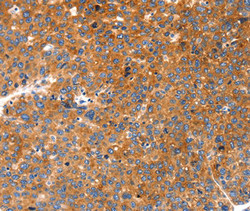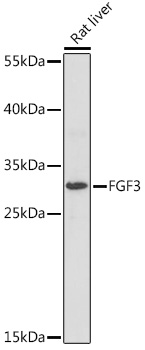FGF3 antibody [3F18]
GTX52740
ApplicationsWestern Blot, ImmunoHistoChemistry, ImmunoHistoChemistry Paraffin, Neutralisation/Blocking
Product group Antibodies
TargetFGF3
Overview
- SupplierGeneTex
- Product NameFGF3 antibody [3F18]
- Delivery Days Customer9
- Application Supplier NoteWB: 1:500 - 1:1000. IHC-P: 1:20 - 1:100. *Optimal dilutions/concentrations should be determined by the researcher.Not tested in other applications.
- ApplicationsWestern Blot, ImmunoHistoChemistry, ImmunoHistoChemistry Paraffin, Neutralisation/Blocking
- CertificationResearch Use Only
- ClonalityMonoclonal
- Clone ID3F18
- Concentration500 ug/ml
- ConjugateUnconjugated
- Gene ID2248
- Target nameFGF3
- Target descriptionfibroblast growth factor 3
- Target synonymsHBGF-3, INT2, fibroblast growth factor 3, FGF-3, INT-2 proto-oncogene protein, V-INT2 murine mammary tumor virus integration site oncogene homolog, fibroblast growth factor 3 (murine mammary tumor virus integration site (v-int-2) oncogene homolog), heparin-binding growth factor 3, murine mammary tumor virus integration site 2, mouse, oncogene INT2, proto-oncogene Int-2
- HostMouse
- IsotypeIgG2
- Protein IDP11487
- Protein NameFibroblast growth factor 3
- Scientific DescriptionThe protein encoded by this gene is a member of the fibroblast growth factor (FGF) family. FGF family members possess broad mitogenic and cell survival activities and are involved in a variety of biological processes including embryonic development, cell growth, morphogenesis, tissue repair, tumor growth and invasion. This gene was identified by its similarity with mouse fgf3/int-2, a proto-oncogene activated in virally induced mammary tumors in the mouse. Frequent amplification of this gene has been found in human tumors, which may be important for neoplastic transformation and tumor progression. Studies of the similar genes in mouse and chicken suggested the role in inner ear formation. [provided by RefSeq, Jul 2008]
- Storage Instruction-20°C or -80°C,2°C to 8°C
- UNSPSC12352203





